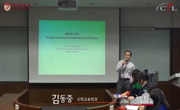We could see the fact that the muscles that have the most influence on facial expression were forehead muscle, occipital muscle and cheekbone muscle. Various expressions have been produced according to relaxation of these muscles, degree of contractio...
http://chineseinput.net/에서 pinyin(병음)방식으로 중국어를 변환할 수 있습니다.
변환된 중국어를 복사하여 사용하시면 됩니다.
- 中文 을 입력하시려면 zhongwen을 입력하시고 space를누르시면됩니다.
- 北京 을 입력하시려면 beijing을 입력하시고 space를 누르시면 됩니다.
https://www.riss.kr/link?id=A82755137
- 저자
- 발행기관
- 학술지명
- 권호사항
-
발행연도
2007
-
작성언어
English
- 주제어
-
KDC
505
-
자료형태
학술저널
-
수록면
49-54(6쪽)
- 제공처
-
0
상세조회 -
0
다운로드
부가정보
다국어 초록 (Multilingual Abstract)
We could see the fact that the muscles that have the most influence on facial expression were forehead muscle, occipital muscle and cheekbone muscle. Various expressions have been produced according to relaxation of these muscles, degree of contraction and the directions of exercise.
While the entire face muscle becomes relaxed for being cheerful, happy, comfortable and surprised showing positive facial expressions, it became relaxed as the cheekbone muscle at both ends of the mouth and forehead muscles performed the upward motion. In other words, various positive facial expressions have been expressed depending on the degree of upward motion at both ends of the mouth and size of mouth opening.
While there was a similarity of entire face muscle becoming contracted for being angry, sad, depressed and weary that are negative facial expressions, the downward motion of forehead muscles around the eye and cheekbone muscles around the mouth going down has been shown.
While 2D characters and 3D characters showed a delicate shade of difference in their method of expression, the 2D character which has excessive distortion and exaggeration for the most part has shown some difference from realistic based 3D Character in that its expression exaggerates and overstates the actual muscle movement of a human being.
목차 (Table of Contents)
- Abstract
- 1. Introduction
- 2. Research Method
- 3. Preceding Researches for Extracting the Facial Expression Pattern of 2D Characters
- 4. The Demonstrative Research to Extract the Facial Expression Pattern of 3D Characters
- Abstract
- 1. Introduction
- 2. Research Method
- 3. Preceding Researches for Extracting the Facial Expression Pattern of 2D Characters
- 4. The Demonstrative Research to Extract the Facial Expression Pattern of 3D Characters
- 5. Comparative Analysis of Facial Expression Pattern In 3D Characters
- 6. Conclusion
- References
동일학술지(권/호) 다른 논문
-
A Study on the Trend of Caption Communication of TV Video Contents
- (사)한국디지털디자인협의회
- Janghan Lim
- 2007
-
An approach of product design by using beneficial material
- (사)한국디지털디자인협의회
- Ik Soo Shin
- 2007
-
An Approach to Development of Product Design
- (사)한국디지털디자인협의회
- Dong Wook Kim
- 2007
-
- (사)한국디지털디자인협의회
- Park Kil-yong
- 2007
분석정보
연관 공개강의(KOCW)
-

Literacy: Character Detectives
Teachers TV Teachers TV -

Literacy: Character Glimpses
Teachers TV Teachers TV -

Literacy: Character Viewpoints
Teachers TV Teachers TV -

Isolation and Characterization of Plasmodesmal Proteins : A Tortuous ,But Rewarding Road!
경상국립대학교 루카스 윌리엄 -

Creativity and Character Education through Mathematics
고려대학교 김동중




 DBpia
DBpia

